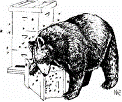Vertebrate Pest Conference: Proceedings

Vertebrate Pest Conference Proceedings: 10th (1982)
Date of this Version
2-23-1982
Document Type
Article
Abstract
Thirteen-lined ground squirrels (Spermophilus tridecemlineatus) and other small rodents damage corn (Zea mays) stands by digging and consuming planted seeds and young seedlings, particularly in reduced-tillage fields. The use of reduced-tillage systems such as ecofarming provides greater dryland crop yields, conserves moisture, reduces soil erosion and provides suitable habitat for ground-nesting birds. The habitat available in these fields also allows various species of rodents to thrive. Reduced-tillage farming is expected to increase markedly in the years ahead; thus, rodent problems will increase as well. Seed repellents offer a promising and cost-effective method of controlling rodent damage to planted corn in some areas. This paper reviews repellents for this use and describes repellency studies currently in progress with the compounds methiocarb [3, 5-dimethyl-4-(methylthio) phenol methylcarbamate] and thiram (tetramethylthiuram disulfide).

